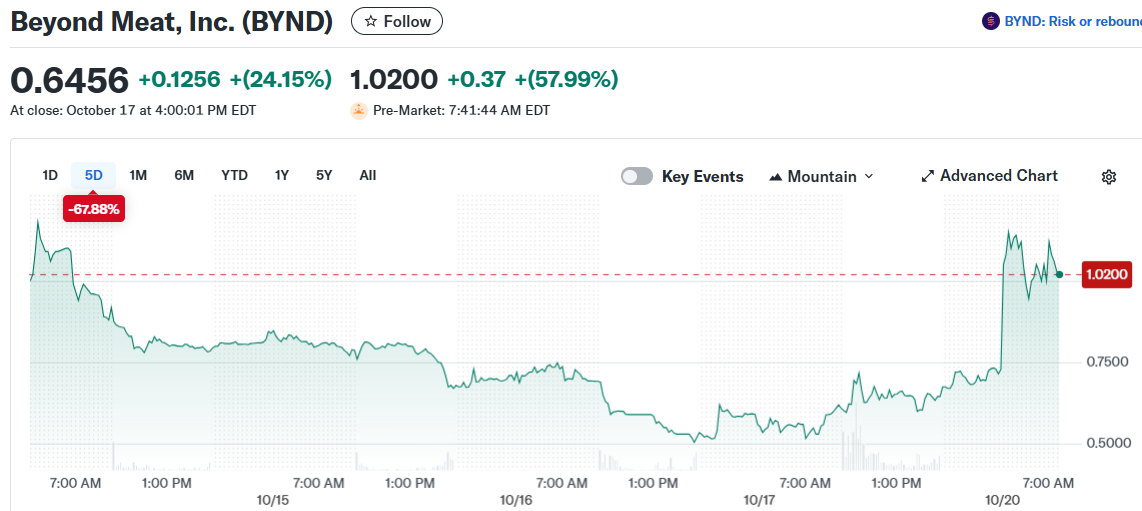TLDR
- Beyond Meat shares rocketed 50% on October 17 as short sellers covered positions, pushing trading volume to 438 million shares versus the typical 13 million daily average.
- A debt-for-equity swap issued 316 million new shares, expanding the float from 76.7 million to over 392 million shares and diluting existing investors.
- The stock trades around $0.65 after falling 97% from its $239 peak in 2019, with short interest at 64% of the float.
- Q2 revenue fell 20% to $75 million while the company holds $117 million cash against $1.2 billion in debt.
- Analysts rate the stock a consensus “Strong Sell” with a median price target of $3, citing declining sales and financial stress.
Beyond Meat stock exploded 50% higher on October 17 in one of the most volatile trading sessions in company history. The move wasn’t based on improved business results. It was a classic short squeeze.

Trading volume reached 438 million shares that day. Normal daily volume runs around 13 million. Short sellers scrambled to cover their positions as the stock bounced from penny stock levels.
Shares closed near $0.65. That marks a 97% decline from the 2019 peak of $239. The stock now sits just above its 52-week low of $0.50.
The volatility stems from an October 13 debt restructuring. Beyond Meat issued 316 million new shares to bondholders as part of a debt-for-equity swap. The move reduced debt but more than quadrupled the outstanding share count from 76.7 million.
Investors initially sold off hard. The stock dropped over 50% on news of the swap, falling below $1. Analysts described it as a “huge dilution bomb” for shareholders.
On October 17, roughly 60 to 63 million newly issued shares became available for trading. This should have pushed prices lower. Instead, the stock rallied 24.6% as shorts rushed to cover.
Beyond Meat ranks as one of the most-shorted U.S. stocks. Short interest sits at 64% of the float. When heavily shorted stocks move higher, it creates pressure on short sellers to buy shares and close positions.
By October 20, the stock surged another 70% in pre-market trading, jumping from $0.64 to $1.08. The continued rally appears driven by short covering rather than fundamental improvements.
Business Performance Deteriorates
The squeeze happened while the underlying business struggles. Second quarter revenue dropped 20% year-over-year to $75 million, missing analyst forecasts.
Beyond Meat withdrew its full-year guidance. Analysts project 2025 revenue will fall 14% to approximately $282 million. The company has posted $931 million in operating losses since 2021.
Cash reserves stand at $117 million. Total debt remains at $1.2 billion despite the restructuring. CEO Ethan Brown acknowledged that consumer trends favor animal meat, leaving “less room for our products and brand.”
The broader plant-based meat sector is contracting. Industry data shows U.S. alternative meat revenues declined 18% over two years as consumers return to traditional meat or switch to competitors.
Wall Street Remains Bearish
Analysts maintain overwhelmingly negative ratings. Beyond Meat has a consensus “Strong Sell” rating. Zero of nine covering analysts recommend buying.
The median 12-month price target is $3. TD Cowen cut its target to $0.80. Argus downgraded to “Sell.” Cowen warned of an “existential threat” without rapid improvement.
Call option volume spiked to 110,588 contracts on October 17, up 151% from normal levels. Speculators are betting the short squeeze continues given the large short position.
Short Squeeze Mechanics Drive Price Action
The debt restructuring issued $208.7 million in new 7% notes due in 2030. This extends maturities and slightly reduces interest costs. However, the equity dilution dramatically increased the share count.
The stock trades well below its 50-day moving average of $2.37. It remains far from the $6 to $7 levels seen in August 2024.
Whether the rally continues depends on short seller behavior and retail trader interest. Most analysts expect the stock to decline once the squeeze ends. The company still needs to demonstrate it can stabilize revenue and improve cash flow.
Institutional investors have largely exited positions. Insider selling has been heavy. Market observers describe the situation as a mechanical price movement driven by positioning rather than business fundamentals.
The October 17 short squeeze was dramatic, but the path forward depends on operational performance rather than trading dynamics.



